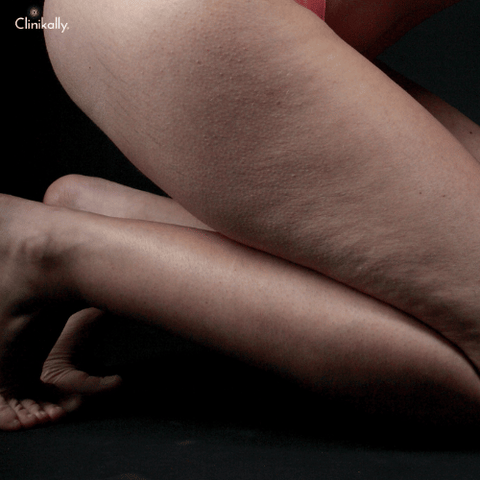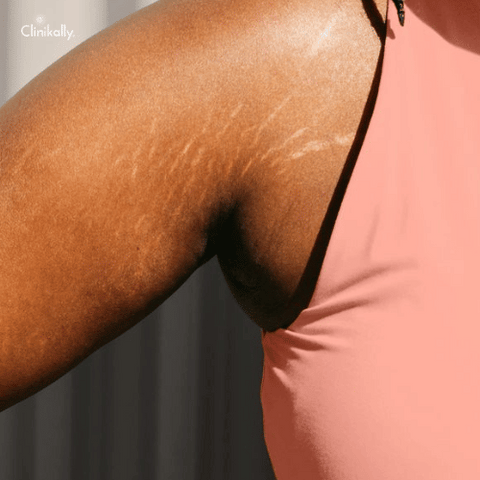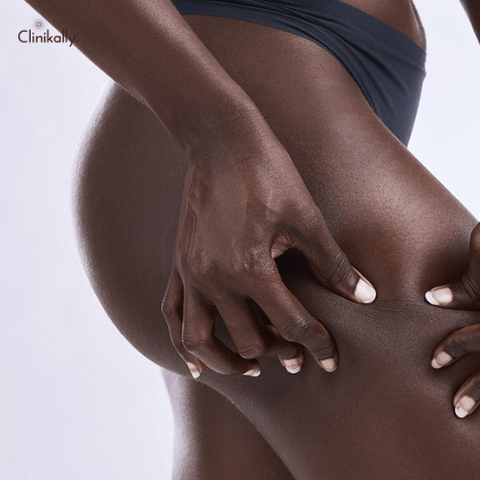Stretch marks are a common concern for many individuals, especially during pregnancy or periods of significant weight gain. With the abundance of stretch mark creams and treatments on the market, it can be challenging to determine which options are the most effective. In this comprehensive guide, we will explore the science behind these creams, assess their effectiveness, and discuss additional approaches to managing and minimizing stretch marks.
Understanding Stretch Marks and Their Causes

Stretch marks are a common skin concern that affects many people, regardless of age, gender, or body type. These lines or streaks on the skin can appear anywhere on the body, but are most commonly found on the abdomen, hips, thighs, and breasts. While stretch marks do not pose any health risks, they can be a source of self-consciousness and insecurity for some individuals. Understanding the causes of stretch marks can help in their prevention and treatment. In this article, we will explore the underlying causes of stretch marks, as well as their prevention and treatment options.
What Are Stretch Marks?
Stretch marks, or striae, are linear scars that develop when the skin is stretched beyond its capacity to accommodate rapid growth. They appear as indented, discoloured streaks on the skin's surface and are often associated with a loss of skin elasticity and collagen. While stretch marks are not harmful, they can cause distress for those who are concerned about their appearance.
Common Causes of Stretch Marks
There are several factors that contribute to the development of stretch marks, including:
-
Pregnancy: As the body expands to accommodate a growing fetus, the skin stretches, and stretch marks may develop.
-
Weight gain: Rapid weight gain can cause the skin to stretch, leading to the formation of stretch marks.
-
Growth spurts: Adolescents may develop stretch marks during growth spurts when their bodies rapidly increase in size.
-
Hormonal fluctuations: Hormonal changes can affect skin elasticity and collagen production, increasing the risk of developing stretch marks.
The Science Behind Stretch Mark Creams

Stretch mark creams are a popular topical treatment option for reducing the appearance of stretch marks. These creams contain various active ingredients that claim to improve the skin's elasticity, reduce inflammation, and promote collagen production. While some stretch mark creams have been shown to be effective, the science behind their mechanisms is still being studied. In this article, we will delve into the science behind stretch mark creams, exploring the different active ingredients commonly found in these creams and their potential benefits for reducing the appearance of stretch marks. We will also discuss the effectiveness of these creams and any potential side effects.
Active Ingredients
Stretch mark creams often contain a combination of active ingredients designed to improve skin elasticity, promote collagen production, and support skin healing. Some common ingredients include:
-
Retinoids: Derived from vitamin A, retinoids can help stimulate collagen production and reduce the appearance of stretch marks.
-
Hyaluronic acid: This ingredient helps to hydrate the skin and improve its elasticity.
-
Peptides: These small proteins can help to stimulate collagen production and support skin healing.
-
Plant extracts: Some creams contain natural extracts, such as centella asiatica or grape seed extract, which can help to improve skin texture and promote skin health.
How Stretch Mark Creams Work
Stretch mark creams work by targeting the underlying causes of stretch marks. They aim to improve skin elasticity, support collagen production, and promote skin healing, thereby minimizing the appearance of stretch marks and preventing new ones from forming. These creams are typically applied topically and absorbed into the skin to deliver their active ingredients.
Evaluating the Effectiveness of Stretch Mark Creams

Stretch marks are a common skin concern that affect many people, particularly women who have experienced pregnancy or weight gain. While there are various treatment options available, stretch mark creams are a popular choice due to their convenience and ease of use. However, the effectiveness of these creams is often questioned, and many people wonder if they truly live up to their claims. In this article, we will evaluate the effectiveness of stretch mark creams and examine the scientific evidence behind their claims. We will also discuss the factors that may influence the effectiveness of these creams and provide practical tips for choosing the best stretch mark cream for your needs.
Prevention vs. Treatment
While stretch mark creams can be effective in preventing the development of stretch marks, they may be less effective in treating existing ones. This is because the creams target the underlying causes of stretch marks, which may have already occurred in the case of existing marks. However, regular use of a stretch mark cream may still help to improve the appearance and texture of existing stretch marks over time.
Factors Influencing Cream Efficacy
The effectiveness of a stretch mark cream can be influenced by several factors, including:
-
The specific active ingredients used
-
The concentration of these ingredients
-
The individual's skin type and genetics
-
The severity of the stretch marks
-
The consistency and duration of use
Timing and Consistency
To maximize the effectiveness of stretch mark creams, it is crucial to apply them consistently and at the appropriate time. For prevention, it is best to start using a cream during the early stages of pregnancy or before significant weight gain occurs. For treatment, it is important to apply the cream consistently over an extended period, as improvements in the appearance of stretch marks may take time to become noticeable. Following the instructions provided by the manufacturer and maintaining a consistent skincare routine can greatly impact the cream's efficacy.
Additional Approaches to Stretch Mark Management

While stretch mark creams are a popular treatment option for reducing the appearance of stretch marks, they are not the only approach to managing this skin concern. In addition to topical treatments, there are various other approaches that can be used to improve the appearance of stretch marks, including lifestyle changes, cosmetic procedures, and alternative therapies. In this article, we will explore these additional approaches to stretch mark management, discussing their potential benefits and drawbacks. We will also provide practical tips for incorporating these approaches into your stretch mark management routine, helping you achieve smoother and more even-looking skin.
Natural Remedies
In addition to using stretch mark creams, some individuals may find relief through natural remedies. These options can help support skin health and may complement the use of topical treatments. Some popular natural remedies include:
-
Aloe vera: Known for its soothing and healing properties, aloe vera can help to improve skin elasticity and hydration.
-
Cocoa butter: This natural moisturizer can help to keep the skin supple and hydrated, potentially reducing the risk of stretch marks.
-
Vitamin E: As an antioxidant, vitamin E can help to protect and repair the skin, possibly minimizing the appearance of stretch marks.
-
Coconut oil: This natural oil can help to moisturize the skin and promote skin health, potentially reducing the risk of developing stretch marks.
Professional Treatments
For individuals seeking more aggressive treatment options, there are several professional treatments available to help manage and minimize the appearance of stretch marks. Some of these options include:
-
Microneedling: This procedure involves the use of tiny needles to create micro-injuries in the skin, stimulating collagen production and promoting skin healing.
-
Laser therapy: Lasers can help to stimulate collagen production, reduce redness, and improve skin texture, which may reduce the appearance of stretch marks.
-
Chemical peels: These treatments involve the application of a chemical solution to the skin to remove the outer layer and promote skin regeneration, potentially improving the appearance of stretch marks.
Lifestyle Factors
Adopting certain lifestyle habits can help to support skin health and may reduce the risk of developing stretch marks. Some strategies include:
-
Maintaining a healthy diet: Consuming a balanced diet rich in vitamins, minerals, and antioxidants can help to support skin health and promote collagen production.
-
Staying hydrated: Drinking enough water is essential for maintaining skin hydration and elasticity.
-
Exercising regularly: Physical activity can help to maintain healthy body weight and support skin health.
-
Moisturizing the skin: Keeping the skin hydrated and moisturized can help to maintain its elasticity and reduce the risk of developing stretch marks.
Conclusion: Making the Most of Stretch Mark Creams and Treatments

When it comes to choosing a stretch mark cream, it's important to do your research and look for products that contain active ingredients such as retinoids, hyaluronic acid, and vitamin C, which have been shown to be effective in reducing the appearance of stretch marks. It's also important to follow the instructions carefully and be patient, as it may take several weeks or months to see results.
In addition to using stretch mark creams, a healthy lifestyle can also contribute to the prevention and management of stretch marks. Maintaining a healthy weight through diet and exercise can help to prevent the development of new stretch marks, while also supporting the healing of existing ones. Drinking plenty of water and staying hydrated can also help to improve skin elasticity, making it less susceptible to developing stretch marks.
For those who are looking for additional treatment options, cosmetic procedures such as laser therapy and microdermabrasion can help to improve the appearance of stretch marks. These procedures work by removing the top layers of skin, which can stimulate collagen production and encourage the growth of new, healthier skin cells. However, it's important to note that these treatments can be expensive and may not be covered by insurance.
Alternative therapies, such as massage therapy and acupuncture, may also be effective in reducing the appearance of stretch marks. These therapies work by increasing blood flow to the affected area and promoting the body's natural healing process. While the effectiveness of these therapies is still being studied, they may provide a non-invasive and affordable option for those who are seeking additional support in managing their stretch marks.
In conclusion, stretch mark creams can be an effective tool in the management of stretch marks, but they are not the only option available. By incorporating healthy lifestyle habits and exploring additional treatment options, individuals can take an active role in improving their skin health and reducing the appearance of stretch marks. It's important to remember that every individual's skin is unique, and what works for one person may not work for another. By being patient and consistent in their approach to stretch mark management, individuals can achieve smoother, healthier-looking skin and feel more confident in their own bodies.
















